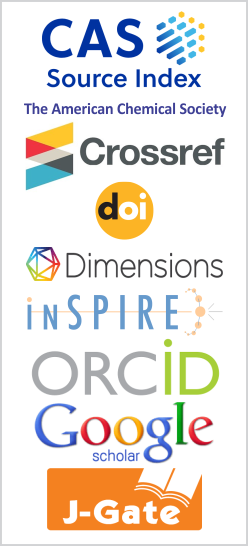Preface
DOI:
https://doi.org/10.26713/jamcnp.v9i1.1965Abstract
The 21st National Conference on Solid State Nuclear Track Detectors and Their Applications (SSNTDs-21), a three-day national conference was jointly organized by the Department of Physics, Ramjas College and Department of Physics and Astrophysics, University of Delhi in collaboration with the Nuclear Track Society of India (NTSI) during January 29-31, 2021. This was the 21st conference into biennial series of the conferences and was inaugurated by Prof. P.C. Joshi, Vice Chancellor, University of Delhi and Prof. Mahesh Verma, Vice Chancellor, GGSIP University, Delhi. The organizing team comprised of Dr. Manoj Kumar Khanna, Principal, Ramjas College (as Patron), Prof. P.D. Sahare, Dr. Rajesh Kumar and Dr. Ashok Kumar as the convener, co-convener and organizing secretory of the conference, respectively. The office bearers of NTSI and advisory committee also played a vital role in organizing the conference.
Solid State Nuclear Track Detector (SSNTDs) are a class of passive detectors, developed by R.L. Fleischer, P.B. Price and R.L. Walker in the early 1960 and they have found in numerous applications in various field of science and technology. SSNTDs have been recognize as very potential and effective tools in exploring various research area. Apart from the direct applications of far reaching consequences in nuclear physics, other areas, such as, biomedical sciences, cosmic rays and space physics, environmental sciences geochronology and geophysics, materials sciences, lunar sciences, meteorites and tektites and microanalysis and mine safety, nuclear technology, uranium prospective and most recently nano-/microtechnology, etc. have been greatly influence by SSNTDs.
They have a very important role to play in radiation measurements, micro technology and dosimetry and thus they are potent enough in spreading awareness about the radiation environment and its impact on the general public and the academic peers. In order to disseminate the knowledge generated in this fast-growing field, there was a need to bring material science and radiation community on a common platform and discuss various aspects related to it.
In view of this, the NTSI along with Ramjas College and Department of Physics and Astrophysics, University of Delhi organized a very comprehensive three-day conference, SSNTDs-21 at the University of Delhi. The focused areas of the conference included, basic studies and methodology; latent tracks in materials and ion track technology; heavy ion nuclear physics and cosmic rays; radon/thoron studies; radiation measurements and dosimetry; trace analysis; Nuclear track filters and their applications; fission track dating and geochronology; instrumentation, devices and software in these areas; SSNTDs in teaching; radiation induced modification of materials; luminescence and it’s applications; synthesis and characterization of materials, etc.
The conference was attended by more than 150 scientists, academicians and researchers having 104 oral presentations, 23 invited talks during 12 technical sessions chaired by eminent scientists and scholars. Scientist from different institution and universities all over the country participated in the conference. Young scientist awards were also given under various categories for best papers presentations. The conference was sponsored by UGC, CSIR, INSA and DRDO of Government of India.
This special issue contains some ‘Selected and Peer-Reviewed’ full length 11 papers out of the total more than hundred papers presented in the ‘21st National Conference on Solid State Nuclear Track Detectors and Their Applications’ (SSNTD-21). The articles presented in the conference covered a wide range of topics. However, only articles of high quality were selected and the topics include synthesis, characterization and applications of some inorganic luminescent phosphors for their applications in radiation dosimetry of high-energy radiations including swift heavy ions (SHI) using TL/OSL techniques. There are also papers on polymer solid state track detectors. Some papers on nanophosphors have also been included for their related applications. We hope that this special issue of the ‘Journal of Atomic, Molecular, Condensed Matter and Nano Physics’ will be useful to the workers in this field.
Lead Guest Editor:
Prof. P.D. Sahare
Department of Physics and Astrophysics
University of Delhi
Delhi 110007, India
Associate Guest Editors:
Dr. Rajesh Kumar
University School of Basic and Applied Sciences
GGS Indraprastha University
New Delhi 110078, India
Prof. Ashok Kumar
Department of Physics
Ramjas College (University of Delhi)
Delhi 110007, India
Downloads
Downloads
Published
How to Cite
Issue
Section
License
Authors who publish with this journal agree to the following terms:- Authors retain copyright and grant the journal right of first publication with the work simultaneously licensed under a CCAL that allows others to share the work with an acknowledgement of the work's authorship and initial publication in this journal.
- Authors are able to enter into separate, additional contractual arrangements for the non-exclusive distribution of the journal's published version of the work (e.g., post it to an institutional repository or publish it in a book), with an acknowledgement of its initial publication in this journal.
- Authors are permitted and encouraged to post their work online (e.g., in institutional repositories or on their website) prior to and during the submission process, as it can lead to productive exchanges, as well as earlier and greater citation of published work.




